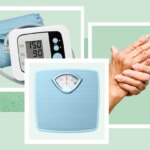Managing inflammatory back pain (IBP) requires some form of prescription medication, typically nonsteroidal anti-inflammatory drugs (NSAIDs) — and potentially a biologic drug, if it’s inflammatory autoimmune back pain due to a known spondyloarthropathy condition such as ankylosing spondylitis or psoriatic arthritis. In addition to the treatment prescribed by your doctor, there are several lifestyle modifications you can make to feel more comfortable and prevent injury.
“Adherence to medical therapy is extremely important,” says Mohamad Bittar, MD, a rheumatologist and an assistant professor of medicine at Oregon Health and Science University in Portland. “With currently available medications, it’s possible to halt progression, but nonadherence can lead to loss of efficacy and, eventually, progression. Progression can lead to serious complications, including spinal deformities and fractures.”
The good news is, if you stick to the treatment recommended by your doctor, you should be able to manage the discomfort associated with IBP. And the following steps can also help.
1. Stay Physically Active to Ease Inflammatory Back Pain
Unlike mechanical back pain, which can worsen with exercise, inflammatory back pain tends to improve after physical activity — the right physical activity, that is. Your doctor should recommend that you see a physical therapist to learn exercises that can relieve pain and strengthen the muscles around your back.
Certain stretches can also help.
“If you have inflammatory back pain, you should remain active and engage in muscle strengthening and stretching exercises to maintain a good spinal posture,” Dr. Bittar notes. “However, you should avoid high-impact exercises that could potentially be harmful to your spine.”
An example of a good stretch for IBP is the seated thoracic extension. To do this stretch, sit in a chair with a low back with your feet flat on the floor and your back straight against the back of the chair. Then place your hands behind your head with your elbows out (or cross your arms over your chest if that’s more comfortable). Keeping your head still, slowly lean backward, so the top of your spine extends over the back of the chair. Hold this position for 10 seconds, then return to the original position.
Before beginning any stretching or exercise regimen, talk to your doctor to make sure you have a plan that will reduce your IBP.
2. Do Deep Breathing Exercises to Maintain Lung Capacity
One type of exercise your doctor or physical therapist may recommend involves breathing. Simple breathing exercises usually involve repeated deep inhaling and exhaling to not only expand your lung capacity but also reduce any inflammation in your rib joints — the joints that connect the ribs to the spine.
If your IBP progresses to ankylosing spondylitis, which it can in many cases, it may affect your rib joints. This could limit the ability of your rib cage to rise and fall as you breathe, making it difficult for your lungs to work properly, particularly during strenuous activity.
3. Learn to Lift Heavy Items Properly
Staying active is great for inflammatory back pain, but heavy lifting isn’t. Your doctor or physical therapist will likely advise you to avoid moving bulky, high-weight objects. And, if you must lift something — a piece of furniture or bag of groceries, for example — you should use techniques recommended by your physical therapist, such as using your leg muscles more than those in your back.
4. Be Careful While Driving
The act of driving in and of itself won’t worsen your IBP. But if you’re ever involved in an accident, your condition may increase your risk of serious injury, including spinal fractures.
“I always tell my patients to be very careful while driving and to avoid sudden movements of the neck or spine,” Bittar says. “Any impact, whether light or strong, can lead to serious problems.”
Of course, accidents happen, as the old saying goes, but if you have inflammatory back pain you can do things to prevent them. For example, avoid driving for extended periods or long distances without breaks — sitting in the car for a long time can worsen aches and stiffness, too — and be sure to stop and rest if you’re starting to feel tired behind the wheel.
If you need to make a phone call or text or reset your GPS unit, pull off the road and stop the vehicle first.
5. Choose the Right Mattress
The right mattress won’t cure your IBP, but it may help you maintain good posture while you rest.
“I recommend sleeping on a firm mattress — not too hard and not too soft,” Bittar says.
It’s best to sleep with your spine in a neutral, aligned position and with your neck in a comfortable position. The Spondilytis Association of America recommends you try sleeping on your back flat with no pillow for some portion of the night, to improve alignment and decrease pressure.
If it’s difficult for you to sleep flat on your back, try placing a thin pillow under your knees.
Good sleep can also help you feel better overall. Research has linked poor sleep with chronic low-back pain.
6. Fall-Proof Your Home to Prevent Fractures
Bittar emphasizes the importance of making your home safe to prevent falls. Because inflammatory back pain increases your risk of spinal fractures, avoiding falls is crucial, he notes.
Keep your home free of “trip points,” such as rolled-up rug corners or cluttered rooms, and be careful on steps and when getting in and out of the shower or bathtub. Nonslip rugs or floor mats in the bathroom and kitchen may also be helpful.
7. Consider a Raised Toilet Seat for Comfort
Speaking of the bathroom, a special raised toilet seat might also relieve any discomfort when using the bathroom and reduce the risk of a fall. Bittar recommends raised toilet seats for his IBP patients with “severe stiffness and spinal deformity.”
8. Adapt Your Workspace for Good Posture
If you’re employed and have inflammatory back pain — and given that the condition typically strikes before age 40, you probably are — look for ways to improve your posture at work. Consider using a standing desk, or ask your employer for an ergonomic chair — or both. You may find it more helpful to alternate between standing and sitting, rather than just doing one or the other.
Positioning your phone or computer screen and keyboard so that you’re not hunched over your desk as you work or forced to reach across your desk to retrieve items can also help reduce strain on your spine.
“I recommend that chairs have a good low-back support and to sit in a straight, upright position,” Bittar notes. “Also, if you sit at your desk a lot at work, you need to get up and move around frequently to stretch and stay loose. Avoid sitting for prolonged periods, preferably no more than 30 minutes at a time.”
9. Dietary Modifications May Improve Symptoms
In addition to treatment, avoiding foods that are inflammatory and eating more foods that are anti-inflammatory might help ease inflammatory back pain.
Foods rich in antioxidants — like colorful fruits and veggies — help fight inflammation. As do foods high in omega-3 fatty acids, such as salmon, flaxseeds, and nuts like almonds and walnuts. Saturated fat, sugar, refined carbohydrates, and processed and fried foods tend to be inflammatory.
Additionally, IBP is a hallmark symptom of spondyloarthropathies like ankylosing spondylitis, a condition that increases your risk of osteoporosis. Getting adequate amounts of calcium and vitamin D in your diet helps reduce the risk of osteoporosis. Consuming one to two alcoholic drinks a day, on the other hand, has been shown to increase the risk of osteoporosis.
Read the full article here




